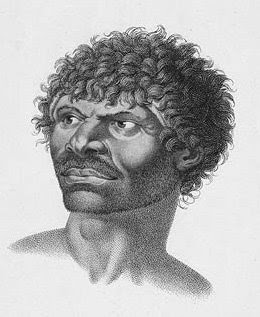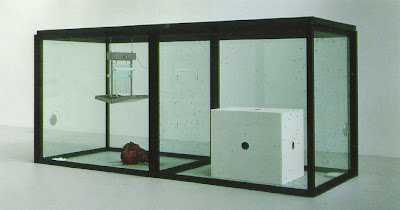Biennale of Sydney 2006 – Zones of Contact
“I hear humanity amiss in a sad plethora of print” – Lawrence Ferlinghetti, c1965
The long-awaited, Charles Merewether-curated 15th Sydney Biennale has finally kicked off, with credit due to all concerned. Le Flaneur has seen about half of it so far, and there’s too much, too new, for a detailed critique, even if I wanted to provide one, which I don’t. - there will be megabytes of words written by others in the coming weeks.
Le Flaneur’s overwhelming impression, to paraphrase Ferlinghetti, is “I hear humanity amiss in a sad plethora of video art and installations about dislocation, dystrophy and despair”.
Of course, there are some extraordinary standouts – the above is more a comment on Biennale-land, internationally, and I suppose I should be at the symposiums discussing the topic, instead of blogging about it, but … somehow the high seriousness of it all becomes relentless and headachy. Loose Projects (above Mori in Day Street), opened on Thursday with a group show called Cones of Zontact – I have to confess to not having made it there yet, but I’m sure it will be interesting, as will safARI, a loose collection of ARIs currently operating as a sort of fringe event.
Back to the main event though, which is pretty fringey and edgy in its own right, being overwhelmingly made up of artists from the Second and Third Worlds, with a major component from the Middle East and West Asia – not often seen here.
The standout, on scale alone, is obviously the majestic Anthony Gormley installation of 150,000 fired clay figures at Pier 2/3 Walsh Bay (above). Adding a powerful dimension of meaning is the frieze (around the other half of the top floor) of close-ups of hundreds of faces – the Chinese villagers who made the figures with Gormley – with next to each face a photo of a figurine made by that person – all in black and white. I spent a long time looking at these mainly thoughtful, serious and beautifully photographed faces, many of them children, and went away profoundly moved by the whole thing.
Other standouts so far:
• Meschac Ghaba’s (Benin) giant kids’ game Le Maison (MCA)
• Brett Graham and Rachael Rakema’s (NZ) beautiful ceiling installation UFOB (MCA)
• Tawatchai Puntusawasdi’s (Thailand) slate ‘drawing’ series Dwelling (MCA)
• Milenko Pravacki’s (Yugloslava>Singapore) huge mixed media paintings (MCA)
• Navjot Altaf’s (India) video/DVD installation with floor mirrors Lacuna in Testimony #1 (MCA)
• Mamma Anderson’s (USA) beautiful and mysterious paintings (AGNSW)
• John Reynolds’ (NZ) installation in the reception area at AGNSW
• Alfredo Juan Aquilizan & Maria Isabel Guadinez- Aquilizan’s (Phillipines) poignant installation of piles of migrant workers meagre belongings In Transit (Ivan Dougherty Gallery)
This last piece has strong superficial similarities with Claire Healey and Sean Cordeiro’s work, showing at GBK Danks Street, but in my view has a ‘ritualised’ power that is lacking in the slightly-too-clever work of Healey and Cordeiro. Perhaps because I felt the genuine poignancy of these poor collections of things that one wouldn’t want – actual people’s things, used and even cherished, neatly arranged in pristine cubes, in a pristine ‘white cube’ – orderly, quiet, sanctified as art… as ironic as it gets.
Finally, what to say about the Biennale Artists’ party at Pier 2/3? For and event where invites were supposedly like hen’s teeth, every art student and ligger in Sydney (including Le Flaneur) seemed to be there – to the event’s advantage – scarved and starved, devouring the tottering boards of thin-crust pizza and freshly carved slabs of ham like there was no (meal) tomorrow. Le Flaneur thought the setting, with Adrian Paci’s giant chandelier as a spectacular centrepiece, and the sight and sound of thousands of panting young artists high on art and the pospect of hot sex, was how Sydney should be every week. The only gripe heard was the fact that there was a paying bar, and prices were far from art-student budgets, with bottled beer and nasty wine at $7.
More Biennale, and especially the fringe, next week.
 Sydney: State Library of NSW
Sydney: State Library of NSWEora: Mapping Aboriginal Sydney
Left: Nouvelle - Hollande. 'Gnoung-a- gnoung-a, mour-re-mour-ga' (dit Collins.) by Barthelemy Roger (1767-1841) after Nicolas-Martin Petit (1777-1804), Engraving, from 'Voyage de découvertes aux terres Australes' by François Péron, 1811.
Launched on the same night as the Biennale, with a VERY different crowd, is this beautifully curated (by Ace Bourke and Keith Vincent Smith) and designed historical survey of documents, maps and images recording the early interaction between the Sydney basin’s original Eeora clans, and the colonists.
There is virtually no ‘documentation’ from the Eora side, so the show is very largely dependent on colonial documents, and the thankfully enlightened attitudes of a series of colonial governors – Phillip, King, Bourke et al, and the fact that they thought it worthwhile to make a visual and verbal record of the culture of the Eora. And there are of course some very vivid and well-known Eora figures – Bennelong, Bunjery and their families, whose ‘assimilation’ (or not) is an integral part of the story.
I agree with Marie Bashir, who opened the exhibition – every Australian child and adult should try to see the show, which is on for several months, and perhaps come away knowing a few Eora words.
 London:
London: Damien Hirst and Francis Bacon at Gagosian Gallery
Opens June 20 2006
Left: © Damien Hirst 'A Thousand Years' (installation view), 1990
Steel, glass, flies, maggots, MDF, insect-o-cutor, cow's head, sugar, water
84 x 168 x 84 inches (213 x 427 x 213 cm)
Courtesy the artist and White Cube, London
It hasn’t escaped LF's notice that these two – one living, one dead, both equally famous – are opening at Gagosian’s London gallery at the same time, on June 20. I also read today that Damien Hirst is now Britain’s richest artist, with a worth of $100 million or more.
Gigabytes have been written about Hirst, much of it hostile, and his firmly ironic post-modern grasp of the zeitgeist (like Jeff Koons’) probably does annoy a lot of people, but there is no denying that he is one of the most profound artists working today – the natural successor to Joseph Beuys dare I suggest? Featured in the London show will be the seminal 1990 vitrine One Thousand Years, you know the one – decaying cows head, insects, insect-o-cutor. Like Beuys, Hirst brings “the powers that exist in the word” (Beuys) into the gallery and the museum without walls, in a horrific and disturbing meditation on mortality, life-cycles, time, and the organic nature of the living world. This work was apparently seen and admired by Francis Bacon in his final days, and Hirst also acknowledges his debt to Bacon, with his own Triptychs (to complement Bacon’s), including a new work The Tranquility of Solitude (For George Dyer. Sounds like a must-see, or at least a ‘must talk-about’ for the chattering classes.
A tout a l’heure.